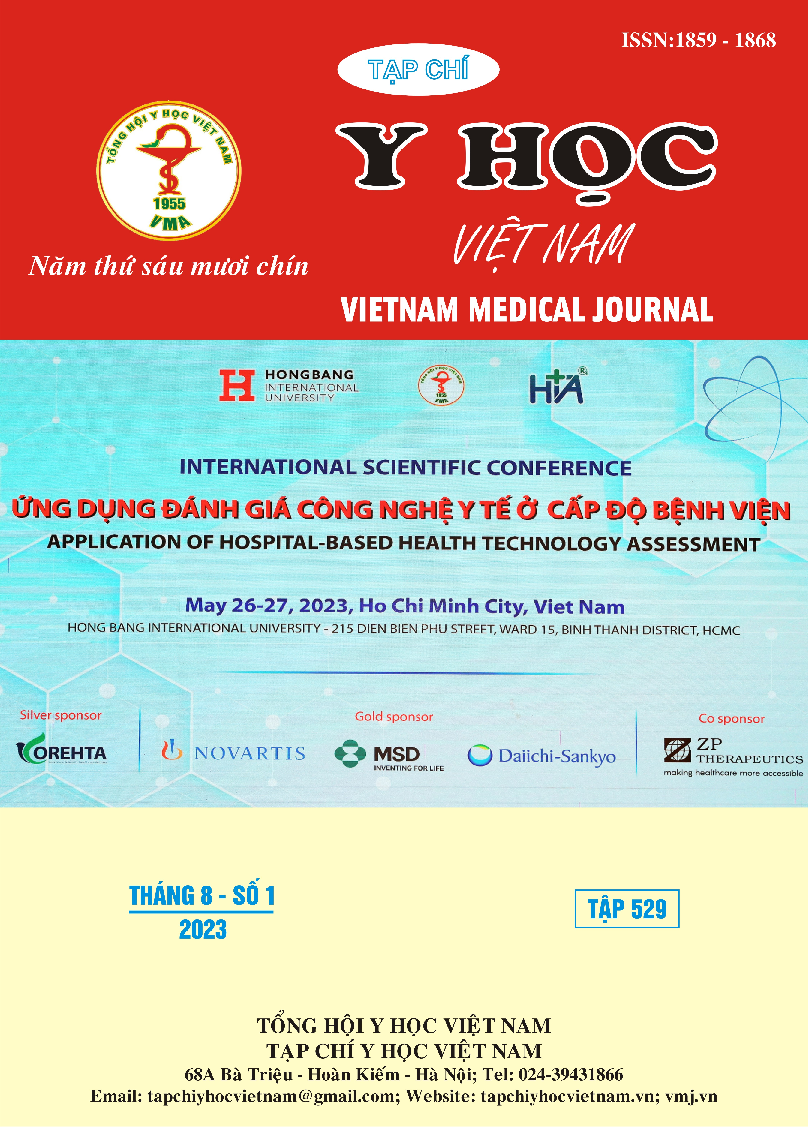KHẢO SÁT BIẾN CHỨNG HUYẾT KHỐI TĨNH MẠCH SÂU TẠI VỊ TRÍ ĐƯỜNG VÀO MẠCH MÁU SAU THỦ THUẬT THĂM DÒ VÀ CAN THIỆP ĐIỆN SINH LÝ TIM
Nội dung chính của bài viết
Tóm tắt
Mục tiêu: Thăm dò điện sinh lý tim (TDDSLT) và triệt đốt rối loạn nhịp tim (RLNT) bằng năng lượng sóng có tần số Radio qua đường ống thông là phương pháp chẩn đoán và điều trị hiệu quả các rối loạn nhịp tim. Tuy nhiên đặc thù là sử dụng nhiều đường vào mạch máu tại tĩnh mạch đùi hoặc động mạch đùi. Việc lưu ống thông trong suốt quá trình thủ thuật là yếu tố nguy cơ hình thành huyết khối tĩnh mạch sâu (HKTMS). Nghiên cứu đánh giá tần suất và một số yếu tố nguy cơ biến chứng bằng siêu âm Doppler. Đối tượng và phương pháp nghiên cứu: Mô tả cắt ngang trên 144 bệnh nhân thực hiện thủ thuật theo dõi dọc 01 tháng tại Bệnh viện Đa khoa Tỉnh Thanh Hoá từ tháng 02 năm 2022 đến tháng 10 năm 2022. Tất cả được siêu âm Doppler mạch máu thường quy trước, ngay sau thực hiện thủ thuật và khi tái khám sau 01 tháng để đánh giá và theo dõi biến cố huyết khối tĩnh mạch. Kết quả nghiên cứu: 144 bệnh nhân (tuổi trung bình 54,7 ± 15,5 với 87% là nữ giới thực hiện thủ thuật (thời gian trung bình 52,9 ± 9,8 phút). Biến chứng huyết khối tĩnh mạch xảy ra trên 10 bệnh nhân (6,9%). Không có khác biệt có ý nghĩa thống kê về tỷ lệ biến chứng giữa hai nhóm: nhóm sử dụng ³ 02 sheaths và nhóm sử dụng 01 sheath. Các yếu tố: Tuổi, giới, BMI, đường kĩnh tĩnh mạch trước khi thực hiện thủ thuật, việc sử dụng ³ 01 sheath tại một vị trí tĩnh mạch đùi, thời gian thực hiện thủ thuật, công suất và nhiệt độ trung bình trong triệt đốt không ảnh hưởng đáng kể đến nguy cơ hình thành huyết khối tĩnh mạch sâu sau thực hiện thủ thuật.
Chi tiết bài viết
Từ khóa
Huyết khối tĩnh mạch sâu, đường vào mạch máu, thăm dò can thiệp điện sinh lý tim.
Tài liệu tham khảo
2. Ouyang F, Cappato R, Ernst S, et al. Electroanatomic Substrate of Idiopathic Left Ventricular Tachycardia: Unidirectional Block and Macroreentry Within the Purkinje Network. Circulation. 2002;105(4):462-469. doi:10.1161/ hc0402.102663
3. Pandian NG, Kosowsky BD, Gurewich V. Transfemoral temporary pacing and deep vein thrombosis. Am Heart J. 1980;100(6):847-851. doi:10.1016/0002-8703(80)90065-4
4. Joynt GM, Kew J, Gomersall CD, Leung VYF, Liu EKH. Deep Venous Thrombosis Caused by Femoral Venous Catheters in Critically Ill Adult Patients. Chest. 2000;117(1):178-183. doi:10.1378/chest.117.1.178
5. Hughes P, Scott C, Bodenham A. Ultrasonography of the femoral vessels in the groin: implications for vascular access: Forum. Anaesthesia. 2000;55(12):1198-1202. doi:10.1046/ j.1365-2044.2000.01615-2.x
6. Moneta GL, Bedford G, Beach K, Strandness DE. Duplex ultrasound assessment of venous diameters, peak velocities, and flow patterns. J Vasc Surg. 1988;8(3):286-291. doi:10.1067/mva. 1988.avs0080286
7. Killewich LA, Macko RF, Cox K, et al. Regression of proximal deep venous thrombosis is associated with fibrinolytic enhancement. J Vasc Surg. 1997;26(5):861-868. doi:10.1016/S0741-5214(97)70101-0
8. Meissner MH, Manzo RA, Bergelin RO, Strandness DE. Venous diameter and compliance after deep venous thrombosis. Thromb Haemost. 1994;72(3):372-376.
9. Chen JY, Chang KC, Lin YC, Chou HT, Hung JS. Safety and Outcomes of Short-Term Multiple Femoral Venous Sheath Placement in Cardiac Electrophysiological Study and Radiofrequency Catheter Ablation. Jpn Heart J. 2004;45(2):257-264. doi:10.1536/jhj.45.257
10. Bruce C, Saraf K, Rogers S, et al. Deep Vein Thrombosis is Common After Cardiac Ablation and Pre-Procedural D-Dimer Could Predict Risk. Heart Lung Circ. 2022;31(7):1015-1022. doi: 10.1016/ j.hlc.2022.01.014


